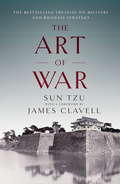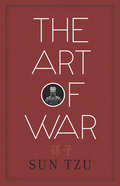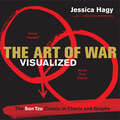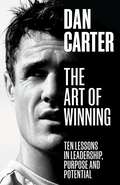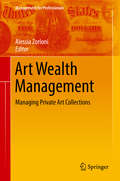- Table View
- List View
The Art of Vulture Investing: Adventures in Distressed Securities Management (Wiley Finance #609)
by George SchultzeA detailed and compelling look at distressed securities investing in today’s market In the corporate world, “vulture” investors in distressed securities serve the same cleanup function as vultures do in the natural world: they deal with failing companies, digest bad debt, and mop up after bankruptcies. Since this market’s structural and legal complexities create greater inefficiencies than in other investment fields, it’s a style of investing that can make money during both booms and busts. While recent economic carnage has made opportunities for vulture investors, more convoluted bankruptcies, conflicts of interest, and even government intervention have made this arena harder to negotiate. Nobody understands this better than author George Schultze, founder of Schultze Asset Management. During his successful career as a vulture investor, he’s learned a number of lessons and developed an investment philosophy that has served him well. Now, in The Art of Vulture Investing, Schultze shares his valuable insights and experiences with you. Engaging and informative, this reliable guide offers a bird’s-eye into the opportunities and risks associated with vulture investing. And while it may not always be pretty, you’ll see exactly why this process is necessary for our economic ecosystem. Throughout this book, Schultze explains the theory and strategy of vulture investing in clear and lively prose, illustrating each concept with examples from his own varied experience that show how the landscape has changed in recent years. Offers valuable information on distressed securities investing since the 2007-2009 financial crisis Examines the opportunities and dilemmas for modern vulture investors Includes in-depth case studies of high-profile bankruptcies, including those of Chrysler Automotive and Tropicana Casinos and Resorts By its very nature, investing in distressed companies can be a complicated and risky business. But once the dust settles, these investments can yield extraordinary profits. The Art of Vulture Investing puts this discipline in perspective and shows you how to excel at this difficult, yet rewarding, endeavor.
The Art of Vulture Investing: Adventures in Distressed Securities Management (Wiley Finance #609)
by George SchultzeA detailed and compelling look at distressed securities investing in today’s market In the corporate world, “vulture” investors in distressed securities serve the same cleanup function as vultures do in the natural world: they deal with failing companies, digest bad debt, and mop up after bankruptcies. Since this market’s structural and legal complexities create greater inefficiencies than in other investment fields, it’s a style of investing that can make money during both booms and busts. While recent economic carnage has made opportunities for vulture investors, more convoluted bankruptcies, conflicts of interest, and even government intervention have made this arena harder to negotiate. Nobody understands this better than author George Schultze, founder of Schultze Asset Management. During his successful career as a vulture investor, he’s learned a number of lessons and developed an investment philosophy that has served him well. Now, in The Art of Vulture Investing, Schultze shares his valuable insights and experiences with you. Engaging and informative, this reliable guide offers a bird’s-eye into the opportunities and risks associated with vulture investing. And while it may not always be pretty, you’ll see exactly why this process is necessary for our economic ecosystem. Throughout this book, Schultze explains the theory and strategy of vulture investing in clear and lively prose, illustrating each concept with examples from his own varied experience that show how the landscape has changed in recent years. Offers valuable information on distressed securities investing since the 2007-2009 financial crisis Examines the opportunities and dilemmas for modern vulture investors Includes in-depth case studies of high-profile bankruptcies, including those of Chrysler Automotive and Tropicana Casinos and Resorts By its very nature, investing in distressed companies can be a complicated and risky business. But once the dust settles, these investments can yield extraordinary profits. The Art of Vulture Investing puts this discipline in perspective and shows you how to excel at this difficult, yet rewarding, endeavor.
The Art of Waking People Up: Cultivating Awareness and Authenticity at Work (J-B Warren Bennis Series)
by Kenneth Cloke Joan GoldsmithIn The Art of Waking People Up authors Kenneth Cloke and Joan Goldsmith draw on more than thirty years of practical experience with hundreds of organizations-- from Fortune 500 companies to government agencies, schools, and nonprofits-- to reveal new ways of giving and receiving feedback that maximize personal and organizational change and foster lifelong learning. They show how organizations can develop the systems, processes, techniques, and relationships that affirm, rather than undermine, the intelligence and humanity of their employees. This important resource is filled with the necessary tools, interventions, and strategies managers can use to encourage their employees to speak, hear, absorb, and use the information they need to improve the way they work.
The Art of War: The Essential Translation Of The Classic Book Of Life (Penguin Modern Classics Ser. #909)
by James Clavell Sun TzuSun Tzu was one of the greatest army generals who ever lived. He wrote The Art of War in the fifth century BC and yet his words are still resoundingly relevant to our modern lives. His writings on aspects of warfare from the laying of plans to the tactics and psychology of manoeuvering an army, to the proper use of spies, resonate for us in today's world of cut-throat, ruthless business. With James Clavell's insightful foreword and notes, this classic is widely seen as a necessity on the bookshelf of military leaders and boardroom executives alike.
The Art of War (Penguin Modern Classics #909)
by Sun TzuRegarded as the world's oldest military treatise, this compact volume has instructed officers and tacticians for more than 2,000 years. From its origins in China, The Art of War traveled the world to inform the strategies of Napoleon and World War II generals. More recently, it has taken on a new life as a guide to competing successfully in business, law, and sports.All of The Art of War's concepts retain their value to modern readers, from the prudence of circumventing a strong opponent and taking advantage of a weak one to the wisdom of preparedness and flexibility. Other topics include strategy, tactics, maneuvering, communications, the treatment of soldiers, and the worth of well-trained officers. History enthusiasts, business thought leaders, and anyone intrigued by competition and rivalry will appreciate this elegant edition of the classic work.
The Art of War: The Ancient Classic (Capstone Classics Ser. #2)
by Sun TzuThe original and bestselling leadership book! Sun Tzu's ideas on survival and success have been read across the world for centuries. Today they can still be applied to business, politics and life. The Art of War demonstrates how to win without conflict. It shows that with enough intelligence and planning, it is possible to conquer with a minimum of force and little destruction. This luxury hardback edition includes an introduction by Tom Butler-Bowdon that draws out lessons for managers and business leaders, and highlights the power of Sun Tzu's thinking in everyday life.
The Art of War: The Ancient Classic (Capstone Classics #2)
by Sun TzuThe original and bestselling leadership book! Sun Tzu's ideas on survival and success have been read across the world for centuries. Today they can still be applied to business, politics and life. The Art of War demonstrates how to win without conflict. It shows that with enough intelligence and planning, it is possible to conquer with a minimum of force and little destruction. This luxury hardback edition includes an introduction by Tom Butler-Bowdon that draws out lessons for managers and business leaders, and highlights the power of Sun Tzu's thinking in everyday life.
The Art of War: The Essential Translation Of The Classic Book Of Life (Penguin Modern Classics Ser. #909)
by Sun Tzu‘In peace prepare for war, in war prepare for peace.’ ‘Appear weak when you are strong, and strong when you are weak.’ ‘The supreme art of war is to subdue the enemy without fighting.’ Written 2,500 years ago by the Chinese general Sun Tzu, The Art of War is revered today as the world’s most important commentary on war and peace. A poetic and potent treatise on military strategy, it has established its significance as an invaluable guide to using skill, cunning, tactics and discipline to outwit the opponent – in diplomacy, public administration and corporate leadership. This edition – containing an illuminating foreword by bestselling author Dr Radhakrishnan Pillai that contrasts Sun Tzu’s text with Chanakya’s Arthashastra – is a must-read for all those who want to gain a deeper understanding of strategic decision-making.
The Art of War for Executives: Sun Tzu's Classic Text Interpreted for Today's Business Reader
by Donald G. KrauseFor years, business schools and professional consultants have turned to Sun Tzu's 2,500-year-old Chinese text for its invaluable commentary on such topics as leadership, strategy, organisation, competition and cooperation. Now the wisdom of Sun Tzu's The Art of War is made accessible to the modern reader. Not simply a new translation, this is the first book to provide a clear, easy-to-follow interpretation of the classic document. The Art of War for Executives reveals the brilliance of Sun Tzu - and shows how to win on the battlefield of modern business. The tone and insight of the original classic remain, whilst incorperating the ideas of contemporary business philosophers, like Peters, Drucker and Bennis. Here at last is an accessible interpretation of Sun Tzu's The Art of War incorperating modern business lessons to make this classic text relevant and readable for today's executive facing strategic and competitive challenges.
The Art of War for Security Managers: 10 Steps to Enhancing Organizational Effectiveness
by Scott WatsonThe classic book The Art of War (or as it is sometimes translated, The Art of Strategy) by Sun Tzu is often used to illustrate principles that can apply to the management of business environments. The Art of War for Security Managers is the first book to apply the time-honored principles of Sun Tzu’s theories of conflict to contemporary organizational security.Corporate leaders have a responsibility to make rational choices that maximize return on investment. The author posits that while conflict is inevitable, it need not be costly. The result is an efficient framework for understanding and dealing with conflict while minimizing costly protracted battles, focusing specifically on the crucial tasks a security manager must carry out in a 21st century organization.* Includes an appendix with job aids the security manager can use in day-to-day workplace situations* Provides readers with a framework for adapting Sun Tzu's theories of conflict within their own organizations* From an author who routinely packs the room at his conference presentations
The Art of War Visualized: The Sun Tzu Classic in Charts and Graphs
by Jessica HagyIt&’s the perfect meeting of minds. One, a general whose epigrammatic lessons on strategy offer timeless insight and wisdom. And the other, a visual thinker whose succinct diagrams and charts give readers a fresh way of looking at life&’s challenges and opportunities. A Bronze Age/Information Age marriage of Sun Tzu and Jessica Hagy, The Art of War Visualized is an inspired mash-up, a work that completely reenergizes the perennial bestseller and makes it accessible to a new generation of students, entrepreneurs, business leaders, artists, seekers, lovers of games and game theory, and anyone else who knows the value of seeking guidance for the future in the teachings of the past. It&’s as if Sun Tzu got a 21st-century do-over. Author and illustrator of How to Be Interesting, Jessica Hagy is a cutting-edge thinker whose language—comprising circles, arrows, and lines and the well-chosen word or two—makes her an ideal philosopher for our ever-more-visual culture. Her charts and diagrams are deceptively simple, often funny, and always thought-provoking. She knows how to communicate not only ideas but the complex process of thinking itself, complete with its twists and surprises. For The Art of War Visualized, she presents her vision in evocative ink-brush art and bold typography. The result is page after page in which each passage of the complete canonical text (in its best-known Lionel Giles translation) is visually interpreted in a singular diagram, chart, or other illustration—transforming, reenergizing, and making the classic dazzlingly accessible for a new generation of readers.
The Art of Winning: Ten Lessons in Leadership, Purpose and Potential
by Dan Carter**Instant Sunday Times bestseller**Ten timeless truths on leadership, purpose and potential - from the unique culture of the All Blacks, and the mind of a living legend.You might think success at the highest level insulates you from self-doubt.But nothing could be further from the truth.In this book, I take you inside a journey that has forced me to look inwardly in a way I've never had to before. It's been challenging, frustrating, rewarding and left me full of gratitude. Whether you're a leader on a steep learning curve, a person navigating change in their life or just someone of any age trying to get that little bit better every day, I hope that my experience can spur you on to greater heights.For the first time, sporting legend Dan Carter distils his two decades at the frontiers of high-performance into his 'perfect ten' lessons.You won't find conventional wisdom here, but hard-learned truths, including:- Why great leaders are made, not born, and why they must constantly evolve- How to forge a winning team culture- Why embracing your past can be every bit as important as looking towards your future- Why empowering others leads to the best decisions- Why confidence and self-belief are nothing without humility and a beginner's mindsetHonest, surprising and inspiring, The Art of Winning converts a legendary career into timeless lessons for readers in any walk of life. Step inside the unique culture of the All Blacks - and inside the mind of a legend.
The Art of Writing for the Theatre: An Introduction to Script Analysis, Criticism, and Playwriting (Introductions to Theatre)
by Luke YankeeWriting for the theatre and about theatre requires a diverse set of skills, but whether you're studying theatre or developing your creative craft, this book covers everything you need to know. Filled with practical advice from an award-winning playwright, with a range of resources to guide you in the craft and business of theatre writing, The Art of Writing for the Theatre provides everything you need to write like a seasoned theatre professional, including:* how to analyze and break down a script, * how to write various types of plays, from short plays, plays for one person, to one act and full length dramas, * how to critique a play and a theatre production, * how to construct and craft essays, cover letters, theatrical resumes, applications, and * how to avoid common grammar and punctuation errors.This thorough introduction is supplemented with exercises and new interviews with a host of internationally acclaimed playwrights, lyricists, and critics, including Lyn Gardner, Kia Corthron, Ismail Khalidi, Marsha Norman, and David Zippel, among many others. Accompanying online resources include playwriting and script analysis worksheets and exercises, an example of a playwriting resume, and critical points to consider on playwriting, design, acting, directing and choreography.
The Art of Writing for the Theatre: An Introduction to Script Analysis, Criticism, and Playwriting (Introductions to Theatre)
by Luke YankeeWriting for the theatre and about theatre requires a diverse set of skills, but whether you're studying theatre or developing your creative craft, this book covers everything you need to know. Filled with practical advice from an award-winning playwright, with a range of resources to guide you in the craft and business of theatre writing, The Art of Writing for the Theatre provides everything you need to write like a seasoned theatre professional, including:* how to analyze and break down a script, * how to write various types of plays, from short plays, plays for one person, to one act and full length dramas, * how to critique a play and a theatre production, * how to construct and craft essays, cover letters, theatrical resumes, applications, and * how to avoid common grammar and punctuation errors.This thorough introduction is supplemented with exercises and new interviews with a host of internationally acclaimed playwrights, lyricists, and critics, including Lyn Gardner, Kia Corthron, Ismail Khalidi, Marsha Norman, and David Zippel, among many others. Accompanying online resources include playwriting and script analysis worksheets and exercises, an example of a playwriting resume, and critical points to consider on playwriting, design, acting, directing and choreography.
Art, Spirituality and Economics: Liber Amicorum for Laszlo Zsolnai (Virtues and Economics #2)
by Luk Bouckaert Knut J. Ims Peter RonaThis volume celebrates the work of Laszlo Zsolnai, a leading researcher and scholar in the field of the ethical and spiritual aspects of economic life, who has made significant contributions to the connection between ethics, spirituality, aesthetics and economic theory. The book offers a selection of essays concerned with the ethical, spiritual and aesthetic context within which economics as a social studies discipline should be situated in order to avoid the sort of dehumanising consequences that theories based on utility maximisation and rational choice necessarily entail. It presents the economic activities of human beings not as some sort of preordained obedience to universal laws that operate independently of other human concerns, but, rather, as a part of the human desire for the Aristotelian good life. It looks at the various considerations –moral, spiritual and aesthetic – that take part in the formation of economic decisions in sharp contrast with theories that purport to explain economic phenomena solely on the basis of utility maximisation.
The Art Therapist's Guide to Social Media: Connection, Community, and Creativity
by Gretchen M. MillerThe Art Therapist’s Guide to Social Media offers the art therapy community a guide that addresses content related to social media use, its growing influence, and the impact social networking has on the profession and work of art therapists. This book presents a framework of relevant theories, best practices, and examples to explore existing and emerging areas of social networking's power for art therapists as practitioners and artists. Divided into three sections that highlight the themes of connection, community, and creativity, chapters explore timely topics such as the professional use of social media, ethical considerations, potential benefits and challenges, and strategies to embrace the possibilities that social media can create for the field worldwide. Art therapists in training, art therapy educators and supervisors, and practicing art therapists will find content in this text helpful for their learning and professional practice.
The Art Therapist's Guide to Social Media: Connection, Community, and Creativity
by Gretchen M. MillerThe Art Therapist’s Guide to Social Media offers the art therapy community a guide that addresses content related to social media use, its growing influence, and the impact social networking has on the profession and work of art therapists. This book presents a framework of relevant theories, best practices, and examples to explore existing and emerging areas of social networking's power for art therapists as practitioners and artists. Divided into three sections that highlight the themes of connection, community, and creativity, chapters explore timely topics such as the professional use of social media, ethical considerations, potential benefits and challenges, and strategies to embrace the possibilities that social media can create for the field worldwide. Art therapists in training, art therapy educators and supervisors, and practicing art therapists will find content in this text helpful for their learning and professional practice.
Art, Trade, and Cultural Mediation in Asia, 1600–1950
by Raquel A. G. ReyesThis Palgrave Pivot explores the social and cultural impact of global trade at a micro-level from around 1600 to 1950. Bringing together the collaborative skills of cultural, social, economic, and art historians, it examines how the diffusion of trade, goods and objects affected people’s everyday lives. The authors tell several stories: of the role played by a host of intermediaries – such as apothecaries, artisans and missionaries who facilitated the process; of objects such as Japanese export lacquer-ware and paintings; of how diverse artistic influences came to be expressed in colonial church architecture in the Philippines; of revolutionary changes wrought on quotidian tastes and preferences, as shown in the interior decoration of private homes in the Dutch East Indies; and of transformations in the smoking and drinking habits of Southeast Asians. The chapters consider the conditions from which emerged new forms of artistic production and transfer, fresh cultural interpretations, and expanded markets for goods, objects and images.
Art Wealth Management: Managing Private Art Collections (Management for Professionals #0)
by Alessia ZorloniThis book offers an overview of how to manage private art collections, providing essential insights on art wealth management, art investment, art governance, and succession planning for art assets. It offers practical recommendations on sound art collection governance, but also examines the background of art markets and price building, including the influence of fashion and trends. Throughout history, art patronage has played an important role in the wealth of ultra-high-net-worth families and led to private museums funded by philanthropist collectors in order to celebrate their own tastes and leave a lasting legacy. Today, as a result of the growth of art investing by a new generation of wealthy collectors, not only artists but also wealthy families, sophisticated investors and their close advisors now face a more complex set of financial and managerial needs. As such, the contributions in this book will be of interest to collecting families, family offices, and professional advisors seeking to integrate art into their overall wealth management strategy, and to scholars in the fields of cultural economics, art dealers, curators, and art lovers.
Artemisia Gentileschi and the Business of Art
by Christopher R. MarshallA new account of the renowned Baroque painter, revealing how her astute professional decisions shaped her career, style, and legacyArt has long been viewed as a calling—a quasi-religious vocation that drives artists to seek answers to humanity&’s deepest questions. Yet the art world is a risky, competitive business that requires artists to make strategic decisions, especially if the artist is a woman. In Artemisia Gentileschi and the Business of Art, Christopher Marshall presents a new account of the life, work, and legacy of the Italian Baroque painter, revealing how she built a successful four-decade career in a male-dominated field—and how her business acumen has even influenced the resurrection of her reputation today, when she has been transformed from a footnote of art history to a globally famous artist and feminist icon.Combining the most recent research with detailed analyses of newly attributed paintings, the book highlights the business considerations behind Gentileschi&’s development of a trademark style as she marketed herself to the public across a range of Italian artistic centers. The disguised self-portraits in her early Florentine paintings are reevaluated as an effort to make a celebrity brand of her own image. And, challenging the common perception that Gentileschi&’s only masterpieces are her early Caravaggesque paintings, the book emphasizes the importance of her neglected late Neapolitan works, which are reinterpreted as innovative responses to the conventional practices of Baroque workshops.Artemisia Gentileschi and the Business of Art shows that Gentileschi&’s remarkable success as a painter was due not only to her enormous talent but also to her ability to respond creatively to the continuously evolving trends and challenges of the Italian Baroque art world.
Artemisia Gentileschi and the Business of Art
by Christopher R. MarshallA new account of the renowned Baroque painter, revealing how her astute professional decisions shaped her career, style, and legacyArt has long been viewed as a calling—a quasi-religious vocation that drives artists to seek answers to humanity&’s deepest questions. Yet the art world is a risky, competitive business that requires artists to make strategic decisions, especially if the artist is a woman. In Artemisia Gentileschi and the Business of Art, Christopher Marshall presents a new account of the life, work, and legacy of the Italian Baroque painter, revealing how she built a successful four-decade career in a male-dominated field—and how her business acumen has even influenced the resurrection of her reputation today, when she has been transformed from a footnote of art history to a globally famous artist and feminist icon.Combining the most recent research with detailed analyses of newly attributed paintings, the book highlights the business considerations behind Gentileschi&’s development of a trademark style as she marketed herself to the public across a range of Italian artistic centers. The disguised self-portraits in her early Florentine paintings are reevaluated as an effort to make a celebrity brand of her own image. And, challenging the common perception that Gentileschi&’s only masterpieces are her early Caravaggesque paintings, the book emphasizes the importance of her neglected late Neapolitan works, which are reinterpreted as innovative responses to the conventional practices of Baroque workshops.Artemisia Gentileschi and the Business of Art shows that Gentileschi&’s remarkable success as a painter was due not only to her enormous talent but also to her ability to respond creatively to the continuously evolving trends and challenges of the Italian Baroque art world.
The Artful Economist: A New Look at Cultural Economics
by Ilde Rizzo Ruth TowseThis book reassesses central topics in cultural economics: Public finance and public choice theory as the basis for decision-making in cultural and media policy, the role of welfare economics in cultural policy, the economics of creative industries, the application of empirical testing to the performing arts and the economics of cultural heritage. Cultural economics has made enormous progress over the last 50 years, to which Alan Peacock made an important contribution. The volume brings together many of the senior figures, whose contributions to the various special fields of cultural economics have been instrumental in the development of the subject, and others reflecting on the subject's progress and assessing its future direction. Alan Peacock has been one of the leading lights of cultural economics and in this volume Ilde Rizzo and Ruth Towse and the other contributors ably capture the import of his contributions in a broader context of political economy. In doing so, they offer an overview of progress in cultural economics over the last forty years.Tyler Cowen, Professor of Economics and Director of the Mecatus Center, George Mason University, Fairfax, Virginia, USA A fitting tribute to Professor Sir Alan Peacock's inspiring intellect leadership and his outstandingly rich and varied legacy in the domain of cultural economics, this book draws together illuminating analyses and insights from leading cultural economists about the role and value of this dynamic and increasingly policy-relevant field of enquiry. Gillian Doyle, Professor of Media Economics and Director of Centre for Cultural Policy Research, University of Glasgow, UK
Arthur Cecil Pigou (Great Thinkers in Economics)
by Nahid Aslanbeigui Guy OakesThe British economist Arthur Cecil Pigou (1877-59) reconceptualized economics as a theory of economic welfare and a logic of policy analysis. Misconceptions of his work abound. This book, an essay in demystification and the first reading of the entire Pigouvian oeuvre, stresses his pragmatic and historicist premises.
Arthur Cox Employment Law Yearbook 2015
by Arthur Cox Employment Law GroupThis annual Irish publication contains selected cases and materials relevant to Employment Law. Practitioners need to be up to date and this annual publication provides that service. By being selective, and having that selection carried out by experienced lawyers, practitioners are pointed in the right direction. Comprises of:Irish law: decisions of the superior courts, Labour Court, Equality Tribunal, Employment Appeals Tribunal etc; Irish legislation (Workplace Relations Act 2015) and statutory instruments;English law so far as relevant eg common law decisions;EU law: decisions of the Court of Justice of the European Communities and relevant Directives/Regulations; Other material such as Annual Reports of the EAT, the Labour Court, the Health & Safety Authority, the activities of NERA.
Arthur Cox Employment Law Yearbook 2016
by Arthur Cox Employment Law GroupThis annual Irish publication contains selected cases and materials relevant to Employment Law. Practitioners need to be up to date and this annual publication provides that service. By being selective, and having that selection carried out by experienced lawyers, practitioners are pointed in the right direction. The book also covers the significant reforms under new Workplace Relations Act 2015.Comprises of:Irish law: decisions of the superior courts, Labour Court, Equality Tribunal, Employment Appeals Tribunal and the Workplace Relations Commission etc; Irish legislation and statutory instruments;English law so far as relevant eg common law decisions;EU law: decisions of the Court of Justice of the European Communities and relevant Directives/Regulations; Other material such as Annual Reports of employment bodies.


